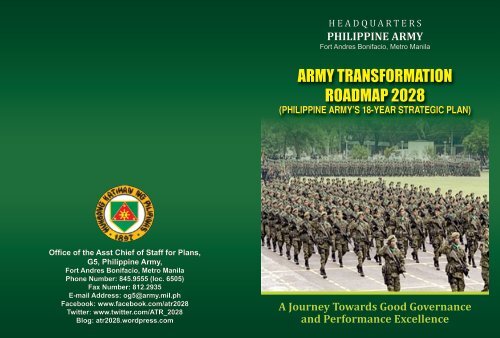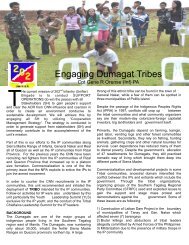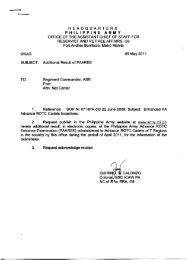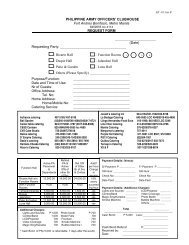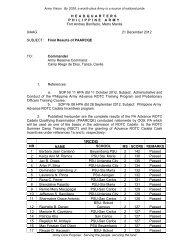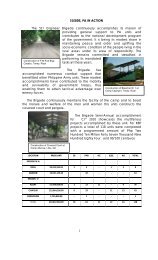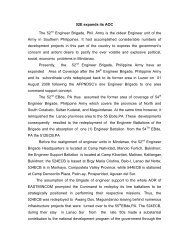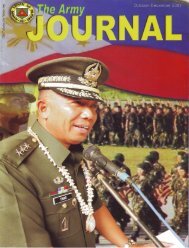ARMY TRANSFORMATION ROADMAP 2028 - Philippine Army
ARMY TRANSFORMATION ROADMAP 2028 - Philippine Army
ARMY TRANSFORMATION ROADMAP 2028 - Philippine Army
You also want an ePaper? Increase the reach of your titles
YUMPU automatically turns print PDFs into web optimized ePapers that Google loves.
Office of the Asst Chief of Staff for Plans,<br />
G5, <strong>Philippine</strong> <strong>Army</strong>,<br />
Fort Andres Bonifacio, Metro Manila<br />
Phone Number: 845.9555 (loc. 6505)<br />
Fax Number: 812.2935<br />
E-mail Address: og5@army.mil.ph<br />
Facebook: www.facebook.com/atr<strong>2028</strong><br />
Twitter: www.twitter.com/ATR_<strong>2028</strong><br />
Blog: atr<strong>2028</strong>.wordpress.com<br />
HEADQUARTERS<br />
PHILIPPINE <strong>ARMY</strong><br />
Fort Andres Bonifacio, Metro Manila<br />
<strong>ARMY</strong> <strong>TRANSFORMATION</strong><br />
<strong>ROADMAP</strong> <strong>2028</strong><br />
(PHILIPPINE <strong>ARMY</strong>’S 18-YEAR STRATEGIC PLAN)<br />
A Journey Towards Good Governance<br />
and Performance Excellence
NOTES
INSIDE THIS KIT<br />
Synopsis 2 – 3<br />
Case for Change 4 – 5<br />
Defining the Strategic Direction:<br />
The <strong>Army</strong> Governance Charter 6 – 8<br />
Outlining the Strategy:<br />
The <strong>Army</strong> Strategy Map 9 – 12<br />
Ensuring Strategy Implementation:<br />
The CGPA Performance Governance<br />
Scorecard 13 – 22<br />
Concrete Steps Undertaken 23 – 24<br />
Early Gains 25<br />
Challenges Encountered 26<br />
Ways Ahead 27 – 28<br />
Frequently Asked Questions 29 – 39
SyNopSIS SyNopSIS<br />
The Armed Forces of the <strong>Philippine</strong>s has always been<br />
in the midst of challenges and controversies that<br />
threaten its stability. Failure to address these may eventually<br />
cause the military institution to crumble from within.<br />
With the understanding that the solution to these challenges<br />
and controversies is reform, the <strong>Philippine</strong> <strong>Army</strong><br />
formulated the <strong>Army</strong> Transformation Roadmap (ATR).<br />
The ATR is a<br />
transformation<br />
program anchored<br />
on the<br />
P e r f o r m a n c e<br />
G o v e r n a n c e<br />
System (PGS).<br />
It highlights the<br />
PA’s commitment<br />
to pursue<br />
a genuine transformationprogram<br />
founded on good governance and performance<br />
excellence. It emphasizes a comprehensive approach in<br />
pursuing reforms and covers all facets of the organization:<br />
from personnel, to resource management, to internal<br />
processes and systems, and to mission accomplishments<br />
and outcomes.<br />
The primary purpose of the ATR is to transform the<br />
PA into a more credible, dynamic, responsive, capable,<br />
and professional <strong>Army</strong> committed to its mandate of serving<br />
the people and securing the land. It further aims to<br />
promote good governance and performance excellence;<br />
to institutionalize the various reform efforts being undertaken<br />
by the organization to successfully optimize their<br />
impact; and to provide a solid, rational, and long-term<br />
basis for the programs, projects, and thrusts of the PA.<br />
In essence, the ATR promotes an <strong>Army</strong> that focuses on<br />
the institution rather than the personalities; thinks about<br />
long-term strategies rather than short-term tactics; and<br />
addresses in a balance manner interconnected priorities<br />
rather than single issues.<br />
The ATR is composed of three key components. First,<br />
the <strong>Army</strong> Governance Charter which defines the strategic<br />
direction of the PA for the next eighteen years. Second,<br />
the <strong>Army</strong> Strategy Map which outlines the strategy and<br />
goals that must be attained in order to realize the vision.<br />
And third, the CGPA Performance Governance Scorecard<br />
which translates broad objectives into measurable items<br />
and actionable details to help facilitate strategy execution,<br />
monitoring, and evaluation.<br />
2 3
CaSE for CHaNgE CaSE for CHaNgE<br />
The PA, being one of the three major service commands<br />
of the AFP, believes there is a need for change. The<br />
compelling reasons that justify the need to transform are<br />
as follows:<br />
• For years, the military institution is plagued with controversies<br />
such as allegations of corruption, military<br />
adventurism, human rights abuses, and revolvingdoor<br />
policy affecting the top leadership. Doubts have<br />
also lingered as to the competence and professionalism<br />
of the soldiers. These issues are deemed by<br />
many to be the unraveling of systemic problems that<br />
long beset the organization. And these have created<br />
imprints of doubts to the Filipino people of the integrity<br />
of the men in uniform. Hence, the PA needs to<br />
have a sustainable solution to these problems.<br />
• The PA needs to address the 3-S of good governance<br />
which involves thinking beyond self, short-term, and<br />
single issues. It must focus on the institution rather<br />
than the personalities.<br />
It must<br />
consider longterm<br />
strategies<br />
rather than shortterm<br />
tactics. And<br />
it must address<br />
comprehensively<br />
interconnected issues<br />
rather than<br />
single problems.<br />
• The PA needs to enhance its critical processes and<br />
systems. For instance, the <strong>Army</strong> must have a longterm<br />
and strategic approach to capability development<br />
that will address the various operational and<br />
organizational issues hounding it.<br />
• The PA needs to pursue and support the current defense<br />
reform programs especially the <strong>Philippine</strong> Defense<br />
Reform Program, the Defense System of Management,<br />
the AFP Modernization Program, and the<br />
AFP Capability Upgrade Program.<br />
In essence, the PA believes a change program is<br />
needed that will promote good governance and performance<br />
excellence. And this transformation program is the<br />
ATR.<br />
4 5
DEfININg THE STraTEgIC DIrECTIoN DEfININg THE STraTEgIC DIrECTIoN<br />
First Key Component: <strong>Army</strong> Governance Charter<br />
The <strong>Army</strong> Governance Charter is the articulation of the<br />
concepts, ideas, and principles defining the character<br />
and the purpose of the PA. Furthermore, it sets the strategic<br />
direction that the organization wants to pursue. The<br />
<strong>Army</strong> Governance Charter is composed of two major elements,<br />
namely: the Core Ideology and the Vision.<br />
Core Ideology<br />
The Core Ideology defines the enduring character of<br />
the PA. It provides a bonding glue that holds the organization<br />
as it grows and moves forward. The Core Ideology<br />
expresses the fundamental ideals and principles the<br />
PA believes in, holds on most to, lives by, and stands for<br />
through the core values and highlights the organization’s<br />
reason for being through the mandated mission and the<br />
core purpose.<br />
Under the ATR, the PA revised and simplified the core<br />
values into three most essential, enduring, and elemental<br />
set of values that truly represent the organization, namely:<br />
1. Honor, which is attributed to self-worth, personal<br />
dignity, integrity, and discipline;<br />
2. Patriotism, which resonates as love of country<br />
and manifests as loyalty, courage, and allegiance<br />
to the constitution; and<br />
3. Duty, which is expressed through professionalism,<br />
excellence, resourcefulness, dynamism,<br />
dedication, and commitment to sworn duty.<br />
These fundamental ideals resound to a strong sense<br />
of commitment to the military institution which is acknowl-<br />
6 7
DEfININg THE STraTEgIC DIrECTIoN ouTlININg THE STraTEgy<br />
edged through the mandated mission: “to organize, train,<br />
equip, deploy, and sustain ground forces in support of the<br />
AFP mission”, likewise, of dedication to the country which<br />
is expressed through the core purpose: “serving the people,<br />
securing the land”. The articulated core purpose goes<br />
beyond the legal mandate and digs deeper into the real<br />
reason for the <strong>Army</strong>’s existence. It provides focus to what<br />
the organization must always aspire to do – the PA exists<br />
to serve the people and it does so principally by securing<br />
the land.<br />
Vision<br />
On such foundation, the PA sets forth a vision that it is<br />
committed to realize: to become “a world-class <strong>Army</strong> that<br />
is a source of national pride” by <strong>2028</strong>.<br />
As the organization ascends towards the envisioned<br />
future, it has set up four base camps along the way that<br />
must be achieved to get closer to the vision. In 2010, it<br />
pursued the transformation program. By 2013, it intends<br />
to become a disciplined and motivated <strong>Army</strong> capable of<br />
addressing all internal security threats. By 2016, it expects<br />
to become a well-equipped <strong>Army</strong> that has established<br />
a respectable image in Southeast Asia. By 2022,<br />
it anticipates to become a modern and respected <strong>Army</strong> in<br />
Asia. And finally by <strong>2028</strong>, the PA will realize the vision.<br />
Second Key Component: <strong>Army</strong> Strategy Map<br />
The <strong>Army</strong> Strategy Map visually captures the strategy<br />
for the envisioned future of the PA. It identifies the<br />
critical factors – perspectives, questions, and themes –<br />
that must be addressed. Conceptually, it illustrates the<br />
cause-and-effect relationship of the strategic objectives<br />
and describes the story on how the organization will be<br />
able to realize the vision.<br />
8 9
ouTlININg THE STraTEgy<br />
The strategic objectives are organized into five strategic<br />
perspectives: stakeholder support, finance and logistics,<br />
human resource, internal processes, and constituency.<br />
In addition, these strategic objectives are further<br />
guided by the three strategic themes: good governance,<br />
operational excellence, and organizational excellence.<br />
The following table shows the thirteen strategic objectives<br />
with their corresponding perspectives outlined in the<br />
ATR:<br />
Strategic<br />
Perspectives<br />
Stakeholder<br />
Support<br />
Finance and<br />
Logistics<br />
Human<br />
Resource<br />
Strategic Objectives<br />
1. Develop and communicate a brand<br />
image consistent with the <strong>Army</strong>’s Core<br />
Values<br />
2. Engage and partner with key<br />
stakeholders<br />
3. Institutionalize good governance<br />
4. Adopt best practices in resource<br />
management<br />
5. Recruit and retain the best and the<br />
brightest<br />
6. Continuously build and develop the<br />
character and the competence of our<br />
personnel<br />
7. Motivate our personnel through<br />
efficient and effective management<br />
Internal<br />
Processes<br />
Constituency<br />
ouTlININg THE STraTEgy<br />
8. Adopt and institutionalize best<br />
practices in management, operations,<br />
and support systems<br />
9. Build and modernize missionessential<br />
capabilities<br />
10. Excel in ground operations<br />
11. Actively support nation-building<br />
12. Responsive to the needs of the<br />
AFP<br />
13. Professional <strong>Army</strong> loved by the<br />
people<br />
The strategic objectives are laid out in a way that<br />
immediately shows their close interconnections. For example,<br />
the two strategic objectives under the stakeholder<br />
support perspective are shown at the bottom (refer to the<br />
<strong>Philippine</strong> <strong>Army</strong> Transformation Roadmap <strong>2028</strong> on page<br />
9) with immediate connection to the two strategic objectives<br />
under the finance and logistics perspective. In this<br />
way, the PA wishes to point out that developing and communicating<br />
a brand image consistent with the <strong>Army</strong>’s core<br />
values and engaging and partnering with key stakeholders<br />
would facilitate institutionalizing good governance and<br />
adopting best practices in resource management for the<br />
purpose of generating sufficient financial and logistical resources.<br />
10 11
ouTlININg THE STraTEgy ENSurINg STraTEgy ImplEmENTaTIoN<br />
Moreover, success in pursuing all the strategic objectives<br />
under the first four perspectives would bring about<br />
success relative to the remaining strategic objectives under<br />
the topmost perspective which is constituency. It is<br />
by actively pursuing the eleven strategic objectives under<br />
the four preceding perspectives that the organization can<br />
look towards succeeding in being responsive to the needs<br />
of the AFP and in becoming a professional <strong>Army</strong> loved by<br />
the people.<br />
This is what the <strong>Army</strong> Strategy Map does. It clearly<br />
demonstrates that by focusing on the eleven strategic objectives<br />
and by vigorously pursuing them, the PA can best<br />
serve the AFP and the entire nation. In the process, the<br />
organization would end up becoming a professional <strong>Army</strong><br />
loved by the people. The final strategic objective may at<br />
first look too ideal to be within grasp even by <strong>2028</strong>, but the<br />
<strong>Army</strong> Strategy Map gives some assurance that difficult as<br />
the road ahead may be, still it is not impossible to travel<br />
on it and to eventually reach the final goal. And since the<br />
different strategic objectives, by their connection, present<br />
many opportunities for a domino effect: succeed in one<br />
or few strategic objectives and success in other strategic<br />
objectives would be much easier to achieve.<br />
Third Key Component: CGPA Performance<br />
Governance Scorecard<br />
The CGPA Performance Governance Scorecard is a<br />
performance measurement mechanism. It is composed<br />
of the following: the performance measures which<br />
assess and track the success of the PA in attaining the<br />
strategic objectives; the performance targets which outline<br />
the level of performance and the rate of improvement<br />
needed by the organization; and the strategic initiatives<br />
which are key programs and projects that must be implemented<br />
to attain the strategic objectives and to realize the<br />
vision.<br />
Performance Measures and Targets<br />
The following twenty one measures and their respective<br />
targets are used to monitor and evaluate the success<br />
of the PA in achieving the goals underscored in the ATR:<br />
1. Net Trust Rating - This measures the level of perceived<br />
trust the general public has on the PA. It<br />
indicates whether the organization is able to live<br />
up to its core values, hence, is able to get the trust<br />
of the general public.<br />
2. Growth Rate of Formalized Partnerships with Key<br />
Stakeholders - This assesses the success of the<br />
PA in institutionalizing its engagements with external<br />
stakeholders.<br />
12 13
ENSurINg STraTEgy ImplEmENTaTIoN<br />
3. Growth Rate of Completed Projects with Key<br />
Stakeholders - This evaluates the success of<br />
<strong>Army</strong> projects undertaken with external stakeholders.<br />
It is expected that engagements with<br />
these stakeholders will result to productive undertakings<br />
which shall benefit the PA.<br />
4. Growth Rate of Resources Generated through<br />
Partnerships with Key Stakeholders - This assesses<br />
the success of the PA in actively engaging<br />
with external stakeholders through the monetary<br />
and non-monetary support they are giving.<br />
5. Number of COA Adverse Findings - This reflects<br />
the success of the PA in encouraging good governance<br />
practices and in following accounting and<br />
auditing requirements.<br />
6. Absorptive Capacity - This pertains to the ability<br />
of the PA to timely obligate and utilize the programmed<br />
funds and to use the available resources<br />
effectively and efficiently.<br />
7. Percentage of Supported Activities Out of the<br />
General Appropriations Act - This looks at the<br />
ability of the PA to financially support its activities<br />
out of the <strong>Army</strong> Budget.<br />
8. Logistics Performance Index - This pertains to the<br />
ability of the PA to immediately respond to the logistical<br />
needs of its offices and units.<br />
ENSurINg STraTEgy ImplEmENTaTIoN<br />
Strategic<br />
Objectives<br />
SO3:<br />
Institutionalize<br />
good governance<br />
SO4: Adopt best<br />
practices in<br />
resource<br />
management<br />
CGPA Performance Governance Scorecard<br />
Perspective:�Stakeholder�Support<br />
Strategic Objectives Measures<br />
SO1:Develop and<br />
communicate a brand<br />
image consistent with<br />
the <strong>Army</strong>’s core<br />
values<br />
SO2: Engage and<br />
partner with key<br />
stakeholders<br />
CGPA Performance Generated through Governance Scorecard<br />
Perspective:�Finance�and�Logistics<br />
14 15<br />
Measures<br />
Number of COA<br />
Adverse Findings<br />
Base Data Targets<br />
2010 2011 2013 2016 2022 <strong>2028</strong><br />
28<br />
(CY2009)<br />
24 20 16 10 6<br />
Absorptive Capacity 98.35% 98.44% 98.50% 98.59% 98.80% 99%<br />
Percent of Supported<br />
PA Activities out of<br />
the General<br />
Appropriations Act<br />
Logistics<br />
Performance Index<br />
Base Data Targets<br />
2010 2011 2013 2016 2022 <strong>2028</strong><br />
Net Trust Rating N / A 10% 20% 35% 60% 80%<br />
Growth Rate of Formalized<br />
Partnerships with Key<br />
Stakeholders<br />
Growth Rate of Completed<br />
Projects with Key<br />
Stakeholders<br />
Growth Rate of Resources<br />
Partnerships with Key<br />
Stakeholders<br />
58<br />
19<br />
10%<br />
(64)<br />
10%<br />
(21)<br />
25%<br />
(73)<br />
25%<br />
(24)<br />
50%<br />
(87)<br />
50%<br />
(29)<br />
200%<br />
(174)<br />
200%<br />
(57)<br />
300%<br />
(232)<br />
300%<br />
(76)<br />
P222M 10% 25% 50% 200% 300%<br />
N / A 70% 76% 85% 98% 99%<br />
N / A 2.6 2.8 3 3.2 3.5
ENSurINg STraTEgy ImplEmENTaTIoN<br />
9. Quality Recruit Index - This reflects the general<br />
quality of those entering the PA.<br />
10. Attrition Rate of Competent Personnel - This<br />
monitors the rate of loss of personnel due to voluntary<br />
separation through resignation, optional<br />
retirement, and / or honorable discharge prior to<br />
ETE.<br />
11. Individual Training Readiness - This measures<br />
the level of preparedness of an individual vis-àvis<br />
the required competencies of his current position.<br />
12. Percentage Reduction of Disciplinary Cases from<br />
Base Data - This reflects the overall state of discipline<br />
in the PA.<br />
13. Personnel Satisfaction Index - This monitors the<br />
level of perceived satisfaction of personnel with<br />
regard to compensations, placements, promotions,<br />
non-monetary benefits, awards and recognitions,<br />
and schoolings and trainings.<br />
14. Doctrine Development Throughput Time - This reflects<br />
the total amount of time spent in developing<br />
a doctrine from its conceptualization to its promulgation<br />
.<br />
15. Number / Percentage of Battalions which completed<br />
the Battalion of Excellence Program - This<br />
reflects the success of the PA Capability Development<br />
Program. The BOE Program builds and<br />
ENSurINg STraTEgy ImplEmENTaTIoN<br />
Strategic Objectives Measures<br />
SO5: Recruit and retain<br />
the best and the<br />
brightest<br />
SO6: Continuously<br />
build and develop the<br />
character and the<br />
competence of our<br />
personnel<br />
SO7: Motivate our<br />
personnel through<br />
efficient and effective<br />
management<br />
Strategic Objectives Measures<br />
SO8: Adopt and<br />
institutionalize best<br />
practices in management,<br />
operations, and support<br />
systems<br />
SO9: Build and<br />
modernize missionessential<br />
capabilities<br />
CGPA Performance Governance Scorecard<br />
Perspective:�Human�Resource<br />
Perspective:�Internal�Processes<br />
Doctrine<br />
Development<br />
Throughput Time<br />
Number /<br />
Percentage of PA<br />
Battalions which<br />
completed the<br />
Battalions of<br />
Excellence Program<br />
Base Data Targets<br />
2010 2011 2013 2016 2022 <strong>2028</strong><br />
Quality Recruit Index N / A 76% 80% 85% 90% 95%<br />
Attrition Rate of<br />
Competent Personnel<br />
Individual Training<br />
Readiness<br />
Percent Reduction of<br />
Disciplinary Cases<br />
from Base Data<br />
CGPA Performance Governance Scorecard<br />
Personnel Satisfaction<br />
Index<br />
2.40% 2.20% 1.80% 1.50% 1.25% 1.00%<br />
Base Data Targets<br />
2010 2011 2013 2016 2022 <strong>2028</strong><br />
16 17<br />
R2 (76%)<br />
1,785<br />
3,248<br />
Days<br />
(8.9 yrs)<br />
R2<br />
(78%)<br />
27%<br />
(1,303)<br />
2,555<br />
Days<br />
(7yrs)<br />
R2<br />
(82%)<br />
35%<br />
(1,160)<br />
1,825<br />
Days<br />
(5yrs)<br />
R1<br />
(86%)<br />
50%<br />
(892)<br />
1,460<br />
Days<br />
(4yrs)<br />
R1<br />
(92%)<br />
70%<br />
(535)<br />
730<br />
Days<br />
(2yrs)<br />
R1<br />
(98%)<br />
90%<br />
(178)<br />
N / A 2.6 3 3.5 4 4.5<br />
365<br />
Days<br />
(1yr)<br />
0 2 6 12 80% 100%
ENSurINg STraTEgy ImplEmENTaTIoN<br />
modernizes the mission-essential capabilities of<br />
<strong>Army</strong> Battalions.<br />
16. Operational Readiness of Combat and Combat<br />
Support Units - This evaluates the operational capability<br />
of the PA’s combat and combat support<br />
units in successfully pursuing their missions.<br />
17. Operational Readiness of Engineers - This assesses<br />
the operational capability of the PA’s engineers<br />
in successfully pursuing their missions<br />
relative to national development.<br />
18. Personnel and Training Readiness of Ready Reserve<br />
Units - This evaluates the capability of the<br />
PA’s ready reserve units in complementing the<br />
activities of the regular troops relative to peacebuilding<br />
and nation-building.<br />
19. Overall Operational Readiness - This measures<br />
the level of preparedness of the PA to respond<br />
to the needs of the AFP. The AFP needs ground<br />
troops which are capable and responsive to its<br />
needs and are operationally ready to perform its<br />
missions.<br />
20. Performance Evaluation Rating - This reflects the<br />
effectiveness and efficiency of the PA in the performance<br />
of its mandated mission.<br />
21. Net Satisfaction Rating: This monitors the level of<br />
perceived satisfaction the general public has on<br />
the PA relative to its mandate.<br />
ENSurINg STraTEgy ImplEmENTaTIoN<br />
Strategic<br />
Objectives<br />
SO10: Excel in<br />
ground<br />
operations<br />
SO11: Actively<br />
support nationbuilding<br />
Strategic<br />
Objectives<br />
SO12:<br />
Responsive to the<br />
needs of the AFP<br />
SO13:<br />
Professional<br />
<strong>Army</strong> loved by the<br />
people<br />
CGPA Performance Governance Scorecard<br />
Perspective:�Internal�Processes<br />
18 19<br />
Measures<br />
Operational<br />
Readiness of Combat<br />
and Combat Support<br />
Units<br />
CGPA Performance Governance Scorecard<br />
Operational Readiness<br />
of Engineers<br />
Personnel and<br />
Training Readiness of<br />
Ready Reserve Units<br />
Perspective:�Constituency<br />
Measures<br />
Overall Operational<br />
Readiness of the PA<br />
Performance<br />
Evaluation Rating<br />
Net Satisfaction<br />
Rating<br />
Base Data Targets<br />
2010 2011 2013 2016 2022 <strong>2028</strong><br />
R3<br />
(72% )<br />
R3<br />
(67% )<br />
N / A<br />
Base Data Targets<br />
2010 2011 2013 2016 2022 <strong>2028</strong><br />
R3<br />
(68%)<br />
R3<br />
(74% )<br />
R3<br />
(70% )<br />
R3<br />
(68% )<br />
R3<br />
(70%)<br />
R2<br />
(78% )<br />
R2<br />
(76% )<br />
R2<br />
(75% )<br />
R2<br />
(75%)<br />
R1<br />
(85% )<br />
R1<br />
(85% )<br />
R1<br />
(85% )<br />
R1<br />
(85%)<br />
R1<br />
(90% )<br />
R1<br />
(90% )<br />
R1<br />
(90% )<br />
R1<br />
(90%)<br />
R1<br />
(95%)<br />
R1<br />
(95%)<br />
R1<br />
(95%)<br />
R1<br />
(95% )<br />
N / A 78% 81% 86% 91% 96%<br />
N / A 10% 20% 35% 60% 80%
ENSurINg STraTEgy ImplEmENTaTIoN<br />
Strategic Initiatives<br />
In order to ensure that the <strong>2028</strong> Vision is realized,<br />
the PA identified the following fifteen strategic initiatives<br />
as the priority programs to be implemented for the next<br />
medium-term (2011 - 2016)<br />
1. <strong>Army</strong> Capability Development Program: Aims to<br />
develop and institutionalize a capability planning<br />
system that will address the capability development<br />
needs of the PA. Also, this aims to improve<br />
the force structure of the organization.<br />
2. Enhancement of the <strong>Army</strong> Logistics System: Intends<br />
to develop an effective, efficient, responsive,<br />
and timely logistics support system. Also,<br />
this intends to improve not only the logistics process<br />
but also the logistics structure.<br />
3. Institutionalization of the <strong>Army</strong> Resource Management<br />
System: Seeks to establish an effective<br />
resource management system that will not only<br />
promote efficient planning, programming, and<br />
budget execution system but will also promote<br />
accountability and transparency. Furthermore,<br />
this seeks to find ways and means of generating<br />
additional funds, over and above GAA, in order to<br />
support the implementation of the projects needed<br />
to realize the <strong>2028</strong> Vision.<br />
ENSurINg STraTEgy ImplEmENTaTIoN<br />
4. Enhancement of the Doctrine Development System:<br />
Aims to improve the PA capability in developing<br />
the needed doctrines that will support the<br />
operational requirements of the organization.<br />
5. Enhancement of the PA Education and Training<br />
Management System: Intends to establish a responsive<br />
education and training system capable<br />
of building and developing the competence of<br />
<strong>Army</strong> personnel and units comparable to Southeast<br />
Asian Armies.<br />
6. Battalion of Excellence Program: Seeks to improve<br />
the operational capability of Infantry and<br />
SOCOM Battalions which are the PA’s cutting<br />
edge units in internal security operations.<br />
7. Enhancement of the <strong>Army</strong> Inspector General<br />
System: Aims to improve the way the PA monitors<br />
and evaluates the readiness and performance of<br />
its operating units.<br />
8. <strong>Army</strong> Character Development Program: Intends<br />
to enhance the state of discipline in the PA.<br />
9. Enhancement of the <strong>Army</strong> International Defense<br />
and Security Engagement Program: Seeks to<br />
have purposive engagements with the PA’s foreign<br />
allies and partners, to optimize the benefits<br />
from these engagements, and to develop a medium-term<br />
IDSE Program.<br />
20 21
ENSurINg STraTEgy ImplEmENTaTIoN<br />
10. ATR Stakeholders Engagement Program: Aims to<br />
promote the ATR in order to generate and sustain<br />
support from both the internal and the external<br />
target audience. Ancillary initiative includes the<br />
measurement of the <strong>Army</strong>’s level of performance<br />
in civil-military operations, likewise, level of contribution<br />
to nation-building.<br />
11. <strong>Army</strong> Intelligence Capability Development Program:<br />
Intends to develop and enhance the intelligence capability<br />
of the PA in order to effectively respond to the<br />
operational needs of the organization.<br />
12. Enhancement of the PA Health Service Support<br />
System: Seeks to develop a responsive health<br />
service support system that will uplift the morale<br />
of personnel especially those in the field.<br />
13. Network Infrastructure Development Program:<br />
Aims to improve the information systems infrastructure<br />
in order to enhance the various management<br />
and operations processes and systems<br />
of the PA.<br />
14. Enhancement of the Reserve Force Development<br />
Program: Intends to institutionalize a comprehensive<br />
Reserve Force build-up in line with the ATR.<br />
15. Expansion of the <strong>Army</strong> Housing Program: Seeks<br />
to uplift the morale and welfare of personnel by<br />
expanding the PA’s on-base and off-base housing<br />
program.<br />
CoNCrETE STEpS uNDErTaKEN<br />
The PA has done the following activities in adopting the<br />
PGS and in implementing the ATR:<br />
1. Organized the ATR Technical Working Group<br />
comprising of representatives from the key staff<br />
of the CGPA.<br />
2. Built the organizational capacity of the Plans Division<br />
by creating the Strategy Management Branch<br />
and by increasing the number of personnel (both<br />
Officers and Civilian Employees) who will focus<br />
on the ATR implementation.<br />
3. Participated in the Institute for Solidarity in Asia’s<br />
Performance Governance System boot camps<br />
and Public Governance fora.<br />
4. Conducted various seminars and workshops in<br />
strategy development, strategy implementation,<br />
performance measurement, and project management<br />
involving the members of the ATR Technical<br />
Working Group and the personnel of the HPA<br />
Staff.<br />
5. Carried out ATR advocacy and information campaigns<br />
to both the internal and the external stakeholders<br />
of the PA.<br />
6. Participated in important HPA-sponsored fora<br />
such as the Battalion Commanders Symposia,<br />
the Company Commanders Symposia, and the<br />
Senior NCO Leaders Symposia.<br />
22 23
CoNCrETE STEpS uNDErTaKEN<br />
7. Took part in the crafting of the PA Support Plan to<br />
the AFP Internal Peace and Security Plan, the formulation<br />
of the PA Annual Operating Program, and<br />
the development of the PA Operating Budget.<br />
8. Developed the project management plans of<br />
the ATR strategic initiatives and allocated PhP<br />
84,218,508 to fund the ATR quick-win projects for<br />
2011.<br />
9. Conducted a series of cascading workshops for<br />
the key staff of the CGPA to align their respective<br />
functions and goals to those underscored in the<br />
ATR and to develop second-level scorecards and<br />
initiatives.<br />
10. Formulated an organizational concept on the PA<br />
Multi-Sector Advisory Board which was approved<br />
by the CGPA.<br />
11. Invited, communicated, and met with the members<br />
of the PA Multi-Sector Advisory Board.<br />
12. Conducted a consultative planning session on Office<br />
of Strategy Management.<br />
13. Continued the various reform efforts started by<br />
the PDR and the DSOM. Placed emphasis on resource<br />
management reforms through a strategydriven<br />
planning, programming, and budgeting<br />
system; enhanced the financial and fiscal management<br />
systems; strengthened the internal control<br />
systems; and pursued the Battalion of Excellence<br />
Program.<br />
Early gaINS<br />
Pursuing the adoption<br />
of the PGS<br />
and the implementation<br />
of the ATR has<br />
been a huge and<br />
demanding task for<br />
the PA. The ATR,<br />
however, has gained<br />
the commitment and<br />
support of the <strong>Army</strong><br />
leadership and the majority of its internal stakeholders.<br />
In effect, the organization has gained enough momentum<br />
to pursue the goals of the ATR. Specifically, it is able to<br />
publish policy directives to guide the ATR implementation;<br />
hasten coordination among HPA Staff on the ATR implementation;<br />
and develop the competencies of the personnel<br />
involved in the ATR implementation.<br />
The ATR has also enabled the alignment of the current<br />
operational priorities with the medium-term capability<br />
development priorities and the long-term strategic direction<br />
of the PA. Further, it has facilitated the execution<br />
and institutionalization of defense reform initiatives such<br />
as the DSOM and the PDR. And it has made possible<br />
the development of both a program and a budget supporting<br />
the transformation initiative and focusing on the<br />
implementation of the identified strategic priorities.<br />
24 25
CHallENgES ENCouNTErED<br />
The PA has encountered the following challenges in the<br />
course of adopting the PGS and of implementing the<br />
ATR:<br />
1. Lack of organizational capacity to implement the<br />
ATR. This is because the PGS is a relatively new<br />
system with the organization still at the bottom of<br />
the PGS learning curve.<br />
2. Lack of organizational alignment to the ATR.<br />
There is a need to align the critical offices and<br />
units, internal processes and systems, and various<br />
programs and projects of the PA to the ATR.<br />
3. Slow implementation of the ATR caused by weak<br />
understanding and appreciation, likewise, competing<br />
requirements and priorities of offices,<br />
units, and personnel.<br />
4. Sustainability of the implementation of the ATR<br />
due to the frequent changes in leadership.<br />
5. Resources needed to pursue the implementation<br />
of the ATR. Some of the strategic initiatives need<br />
capital outlay funds which the current budget<br />
could not support.<br />
6. Support of external stakeholders due to the current<br />
issues besetting the military institution and<br />
affecting its credibility.<br />
To guarantee the successful<br />
and sustained adoption of<br />
the PGS and implementation of<br />
the ATR, the PA will undertake<br />
the following activities:<br />
WayS aHEaD<br />
1. Pursue the PGS Compliance<br />
Stage, the second<br />
stage of the fourstage<br />
Governance<br />
Pathway.<br />
2. Finalize the secondlevel<br />
scorecards of the General Staff, ARMO, and<br />
MFO and institutionalize their adoption and execution<br />
by involving the <strong>Army</strong> Inspector General in the<br />
monitoring of these scorecards.<br />
3. Conduct ATR Cascading Workshops for HPA Staff<br />
and Major Subordinate Units to generate secondlevel<br />
scorecards and strategic initiatives.<br />
4. Execute the strategic initiatives and link these initiatives<br />
to the planning, programming, and budgeting<br />
process of the PA.<br />
5. Carry out an effective ATR advocacy and information<br />
campaign through the ATR Communications<br />
Plan.<br />
6. Establish the PA Multi-Sector Advisory Board<br />
which will help the PA to promote the continuity<br />
and sustainability of the ATR and to encourage<br />
shared responsibility in the success of the ATR.<br />
26 27
WayS aHEaD frEquENTly aSKED quESTIoNS<br />
7. Install mechanisms<br />
and systems<br />
to monitor the ATR<br />
implementation<br />
and the PA performance,<br />
manage<br />
the performance<br />
governance scorecards,<br />
and supervise<br />
the execution<br />
of the strategic initiatives.<br />
8. Build-up the capacity of the PA to implement the<br />
ATR through the establishment of a dedicated unit<br />
which can come in the form of an office of strategy<br />
management.<br />
6. Participate in the development of the AFP Transformation<br />
Roadmap and link with the ATR the said<br />
roadmap.<br />
1. Why do we use the PGS as the framework for the<br />
ATR?<br />
• The <strong>Philippine</strong> <strong>Army</strong> used the PGS for the ATR because<br />
its principles complement the thrusts and goals<br />
of the program. This includes the overall improvement<br />
of the organization by addressing the issues which<br />
hinder the realization of its vision. In addition, both the<br />
PGS and the ATR feature a transparent reporting of<br />
measures, targets, initiatives, and milestones which<br />
are made available to all stakeholders and constituents.<br />
This can assist the PA in establishing the strategy<br />
and the strategic direction, in formulating plans,<br />
and in instituting a monitoring and evaluation system.<br />
In effect, these will enhance the organization and will<br />
facilitate the attainment of the <strong>Army</strong> Vision in <strong>2028</strong>.<br />
2. Where is the <strong>Philippine</strong> <strong>Army</strong> in its governance<br />
journey?<br />
• The PA has already passed the first stage of the fourstage<br />
Governance Pathway when it received the PGS<br />
Initiated Status Award during the Palladium Asia Pacific<br />
Summit and Hall of Fame for Executing Strategy<br />
Awards on 23 September 2010. Currently, it is at the<br />
Compliance Stage, the second stage, of the Governance<br />
Pathway.<br />
28 29
frEquENTly aSKED quESTIoNS<br />
3. Who formulated the ATR?<br />
• The ATR was initially formulated by a group representing<br />
the current and future <strong>Army</strong> leaders comprised<br />
of senior, field grade, and junior officers; enlisted<br />
personnel; and civilian employees during the<br />
Crafting of the <strong>Army</strong> Transformation Roadmap Seminar-Workshop<br />
held at the Sunrise Holiday Mansion,<br />
Royale Tagaytay Estates, Alfonso, Cavite on 19-23<br />
April 2010. The output of the workshop was validated<br />
in a series of consultative meetings by a panel composed<br />
of the CGPA and his staff, the ATR Technical<br />
Working Group (ATR TWG), and civilian subject matter<br />
experts.<br />
• The formulation of the ATR is a result of the partnership<br />
between the PA and the Institute for Solidarity<br />
in Asia. The Office of the Assistant Chief of Staff for<br />
Plans, G5, PA serves as the focal point of this undertaking.<br />
4. What is the role of the ATR TWG in the implementation<br />
of the ATR?<br />
• The ATR TWG represents the offices principally involved<br />
in the ATR implementation. They facilitate the<br />
coordination between and among offices and units<br />
with regard to the ATR implementation. They validate<br />
and integrate the reports, inputs, and data relative<br />
to the generation of the CGPA Performance Governance<br />
Scorecard and second-level scorecards, like-<br />
frEquENTly aSKED quESTIoNS<br />
wise, the execution and management of the strategic<br />
initiatives.<br />
5. Why use the word ‘transformation’? What does<br />
‘transformation’ connote?<br />
• The word ‘transformation’ is used in the ATR to emphasize<br />
the desire of the PA to pursue genuine reforms<br />
in order to transform the <strong>Army</strong> into a better organization.<br />
Transformation does not connote that the<br />
PA is totally broken. Rather, it highlights the fact that<br />
the status quo is no longer acceptable. To effectively<br />
fulfill its mandate and to be responsive to the needs of<br />
its constituents, the organization needs to transform.<br />
6. Is the ATR the ultimate solution to all the problems<br />
of the <strong>Philippine</strong> <strong>Army</strong>?<br />
• As stated earlier, the ATR provides a comprehensive<br />
and sustainable framework to address the various issues<br />
plaguing the PA. It, however, does not immediately<br />
provide solutions to the current problems of the<br />
organization. Nevertheless, it outlines the necessary<br />
steps to be undertaken in order to address the problems<br />
at hand.<br />
7. Why are there only three core values? What about<br />
the other core values?<br />
• This is to get down to the most essential, enduring,<br />
and elemental core values that represent the PA in<br />
30 31
frEquENTly aSKED quESTIoNS<br />
our day and in the next one hundred years. This is<br />
also for operationalization and simplicity. It is not that<br />
the other core values are unimportant but some of<br />
them are considered as attributes of the three core<br />
values and are perceived to support and reinforce the<br />
three core values emphasized.<br />
• The scientific explanation to this is that the average<br />
human brain can only accommodate three ideas at a<br />
time. A person can optimize its comprehension with a<br />
particular issue by limiting the concept into three.<br />
8. Why are the core values ranked?<br />
• Although the core values are all important and are<br />
interconnected, they are ranked to serve as a guide<br />
in the decision making process. Their rank indicates<br />
which of the core values must be considered in making<br />
critical judgments.<br />
9. How do we define a ‘world class army’ as stated in<br />
the <strong>2028</strong> Vision?<br />
• The PA will be considered world-class if it achieves<br />
an international standard of excellence. This means<br />
it will have ample resources, adept personnel, and<br />
innovative and improved internal processes and<br />
systems. It will be equipped with the capabilities to<br />
neutralize any threat or aggression whether internal<br />
or external. It will be operationally ready to perform<br />
the missions set forth by the AFP and the DND. And<br />
frEquENTly aSKED quESTIoNS<br />
it will be able to identify, anticipate, and respond to<br />
the needs of the Filipino people and the <strong>Philippine</strong>s.<br />
Concisely, the PA will be considered world class if<br />
it is well-organized, well-trained, well-equipped, capable,<br />
and professional.<br />
• As a point of reference in Southeast Asia, the PA looks<br />
at the Singapore <strong>Army</strong> and hopes to attain the same<br />
level of organizational and operational capabilities.<br />
10. Can the <strong>Philippine</strong> <strong>Army</strong> be a world class army on<br />
its own?<br />
• The PA does not exist in a vacuum. To be a worldclass<br />
<strong>Army</strong>, the organization needs tremendous resources<br />
and strong support of both its internal and<br />
external stakeholders. Thus, a world-class PA presupposes<br />
that the AFP and the <strong>Philippine</strong>s are also<br />
world-class.<br />
• With the vision to be a world-class <strong>Army</strong>, the PA seeks<br />
to inspire and influence the AFP to work towards becoming<br />
a world-class armed forces and the <strong>Philippine</strong>s<br />
to work towards becoming a world-class country.<br />
11. What is the rationale behind the 18-year timeline<br />
of the ATR? Will this affect the current operational<br />
requirements of the PA?<br />
• The ATR has adopted an 18-year timeline to give<br />
ample time for the transformation it envisions. This<br />
32 33
frEquENTly aSKED quESTIoNS<br />
approach will provide stability to the plans and programs<br />
of the PA. This will also serve as a guide in<br />
the strategic priorities of the CGPA. In this way, the<br />
broader, institutional and long-term interests of the organization<br />
would be advanced.<br />
• This will not affect the current operational requirements<br />
of the PA as it will only serve as a guide and<br />
reference for everyday actions and decisions<br />
• An 18-year timeline is divided into 3 medium-term<br />
planning horizons ( 6 years) of the DND which coincides<br />
with 3 presidential terms.<br />
12. What is the rationale behind the choosing of the<br />
five strategic perspectives of the <strong>Army</strong> Strategy<br />
Map?<br />
• The PA considered the five strategic perspectives<br />
namely: stakeholder support, finance and logistics,<br />
human resource, internal processes, and constituency<br />
because these perspectives ensure a balanced<br />
and comprehensive approach in the development of<br />
the strategy. At the same time, they are responsive to<br />
the <strong>2028</strong> vision.<br />
13. What is the rationale behind the choosing of<br />
the three strategic themes of the <strong>Army</strong> Strategy<br />
Map?<br />
• The PA considered the three strategic themes, namely:<br />
good governance, operational excellence, and or-<br />
frEquENTly aSKED quESTIoNS<br />
ganizational excellence because these are the concepts<br />
and principles that must be propagated and<br />
applied for the organization to realize its vision to be<br />
“a world-class <strong>Army</strong> that is a source of national pride”<br />
by <strong>2028</strong>.<br />
14. What is the difference between stakeholders and<br />
constituency?<br />
• Stakeholders are persons, groups, and organizations<br />
which have direct or indirect interest or involvement<br />
in the organization. In the case of the PA, its stakeholders<br />
are those who can affect or be affected by its<br />
actions, objectives, and policies (e.g. for internal: officers,<br />
enlisted personnel, civilian employees; for external:<br />
academe, church, media, business sector, national<br />
government agencies, local government units,<br />
etc.). On the other hand, constituency is the group of<br />
people who will benefit from the services delivered by<br />
the organization. With respect to the PA, it is the AFP<br />
and the Filipino people.<br />
• The relationship of the PA to the stakeholders is different<br />
from its relationship to the constituents. The<br />
stakeholders are the partners of the PA in the accomplishment<br />
of its missions. On the other hand, the constituency<br />
are the recipients of the services rendered<br />
by the organization. In essence, the PA needs the<br />
participation and support of the stakeholders in order<br />
to respond to the needs of the constituents.<br />
34 35
frEquENTly aSKED quESTIoNS<br />
15. Why does the PA need the support of its stakeholders?<br />
• The ATR is major undertaking of the PA that requires<br />
the support of the stakeholders. This is necessary<br />
to make up for the constraints in implementing the<br />
program. An example of this is the inadequate financial<br />
resources of the organization. To be world class,<br />
the PA needs to have enough resources to enhance<br />
the various elements of the PA. In this instance, the<br />
stakeholders can help out in generating additional resources.<br />
16. How will the <strong>Philippine</strong> <strong>Army</strong> improve the negative<br />
perception the civilians has on the organization?<br />
• The military has been perceived negatively because<br />
of the issues on corruption and violence associated<br />
with it. As one of the major services of the AFP, the PA<br />
needs to improve this negative image through the attainment<br />
of the objectives of the ATR. Some of these<br />
objectives are the following: (1) Develop and communicate<br />
a brand image consistent with the <strong>Army</strong>’s Core<br />
Values, (2) Institutionalize good governance, and (3)<br />
Adopt best practices in resource management. The<br />
attainment of the objectives of the ATR will enable<br />
the PA to promote performance excellence and good<br />
governance. And this will improve the negative perception<br />
of the civilian on the PA.<br />
frEquENTly aSKED quESTIoNS<br />
17. Why is the word ‘loved’ used instead of the word<br />
‘respected’ in Strategic Objective 13?<br />
• The word ‘loved’ is used because it has deeper and<br />
more positive meaning compared to the word ‘respected’.<br />
In addition, being respected is synonymous<br />
to being loved but the same cannot be said of the<br />
reverse since one can be respected but feared by its<br />
constituents. As such, the PA opted to use the word<br />
‘loved’ to have a better relationship with its constituents.<br />
18. What are the benefits to the PA of using a scorecard<br />
system?<br />
• The scorecard system is beneficial to the PA in two<br />
ways:<br />
• It enables the organization to be transparent in its<br />
conduct of missions and to be accountable to the performance<br />
targets it has committed to reach.<br />
• It enables the organization to monitor and report on<br />
performance gains and historical performance progression<br />
through objective data and scores that can<br />
be subjected to public scrutiny and validation.<br />
• Basically, the scorecard system can assess whether<br />
the PA is a highly performing organization or not.<br />
19. What is the rationale behind the choosing of the<br />
fifteen ATR strategic initiatives?<br />
• The fifteen strategic initiatives are chosen based<br />
36 37
frEquENTly aSKED quESTIoNS<br />
on their suitability or high impact on the attainment<br />
of the strategic objectives and eventually the vision;<br />
feasibility or the successful implementation of<br />
the project vis-à-vis time, financial resources, skilled<br />
personnel, and equipment or technology; acceptability<br />
or the conformity of the project to the policies and<br />
thrusts of both the DND and the AFP; and urgency or<br />
the immediate need for the project.<br />
20. What is the relationship between the ATR and the<br />
AFP IPSP “Bayanihan”?<br />
• The ATR and the IPSP support and complement each<br />
other. The ATR prescribes the capability development<br />
and the organizational priorities that support the successful<br />
execution of the IPSP to “win the peace” by<br />
enhancing mission-essential capabilities and by promoting<br />
capacity-building in stakeholder coordination<br />
and partnership.<br />
• Essentially, the ATR satisfies the requirement of the<br />
IPSP on security sector reform because the former<br />
does not only promote good governance, stakeholder<br />
involvement, and adherence to the rule of law but<br />
also intends to bring about a more capable, dynamic,<br />
professional, and responsive <strong>Army</strong>. Therefore, if we<br />
consider the two plans carefully, they actually complement<br />
each other because both espouse the same<br />
concepts and principles.<br />
frEquENTly aSKED quESTIoNS<br />
21. What is the relationship of the PASP to the ATR<br />
and the AFP IPSP “Bayanihan”?<br />
• The PASP basically integrates the two documents.<br />
The ATR provides the policy guidance on the organizational<br />
priorities and thrusts of the <strong>Army</strong> while the<br />
IPSP prescribes the operational imperatives based<br />
on the campaign to “win the peace”. In essence, the<br />
PASP aims to enhance the operational readiness of<br />
the <strong>Army</strong> in internal security operations and territorial<br />
defense and to establish a respectable image in the<br />
Southeast Asia which is the 2016 intermediate vision<br />
outlined in the ATR.<br />
38 39
40<br />
NoTES


